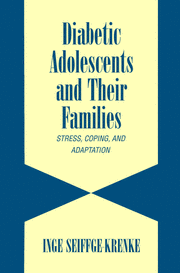Book contents
- Frontmatter
- Contents
- Foreword by Stuart T. Hauser
- Preface
- 1 Epidemiology of Chronic Illnesses in Adolescence
- 2 Coping with Illness in Adolescence: An Overview of Research from the Past 25 Years
- 3 Coping with Diabetes: A Longitudinal Study
- 4 Knowledge of the Illness, Compliance, and Patient–Physician Relationships
- 5 Self-Concept, Body Image, and Perceived Health
- 6 Adolescent, Parental, and Family Coping with Stressors
- 7 Chronic Illness and the Family: The Perspectives of Mothers, Fathers, and Siblings
- 8 Friendships, Romantic Relationships, School, and Career
- 9 Successful Adaptation or the Development of Psychopathology?
- 10 Pathways for Resolving the Dilemma between Developmental Progression and Adaptation to the Illness
- 11 Implications for Prevention and Intervention
- References
- Index
5 - Self-Concept, Body Image, and Perceived Health
Published online by Cambridge University Press: 06 August 2009
- Frontmatter
- Contents
- Foreword by Stuart T. Hauser
- Preface
- 1 Epidemiology of Chronic Illnesses in Adolescence
- 2 Coping with Illness in Adolescence: An Overview of Research from the Past 25 Years
- 3 Coping with Diabetes: A Longitudinal Study
- 4 Knowledge of the Illness, Compliance, and Patient–Physician Relationships
- 5 Self-Concept, Body Image, and Perceived Health
- 6 Adolescent, Parental, and Family Coping with Stressors
- 7 Chronic Illness and the Family: The Perspectives of Mothers, Fathers, and Siblings
- 8 Friendships, Romantic Relationships, School, and Career
- 9 Successful Adaptation or the Development of Psychopathology?
- 10 Pathways for Resolving the Dilemma between Developmental Progression and Adaptation to the Illness
- 11 Implications for Prevention and Intervention
- References
- Index
Summary
Studies of chronically ill adolescents have typically concentrated too much on social resources as factors that can buffer the effects of stress, while neglecting internal resources, such as self-concept and overall health (Cohen & Wills, 1985; Jamison, Lewis, & Burish, 1986). For a long time, studies on diabetic adolescents only focused on certain aspects of internal resources. Corresponding to studies carried out on adults with diabetes, much research concentrated on understanding the “diabetic personality” (Dunn & Turtle, 1981). It is surprising that so little consideration has been given to examining the role of the self-concept, because it is known that this internal resource is central to the process of restructuring identity during adolescence (Dusek & Flaherty, 1981). Moreover, reference has been made to its protective function in coping with illness (Pearlin & Schooler, 1978; Badura, 1971). The neglect of body image in research on chronically ill adolescents is even more puzzling. If one recognizes that the normal processes of physical maturation that take place during adolescence increase the adolescent's interest in and awareness of his or her body, it is reasonable to assume that the changes due to the effects of illness will have a direct bearing on body image. For this reason it is astounding that so few studies have examined how chronically ill adolescents perceive their bodies. In our longitudinal study, results related to body image, self-concept, and general health proved to be especially conclusive.
- Type
- Chapter
- Information
- Diabetic Adolescents and their FamiliesStress, Coping, and Adaptation, pp. 63 - 83Publisher: Cambridge University PressPrint publication year: 2001



